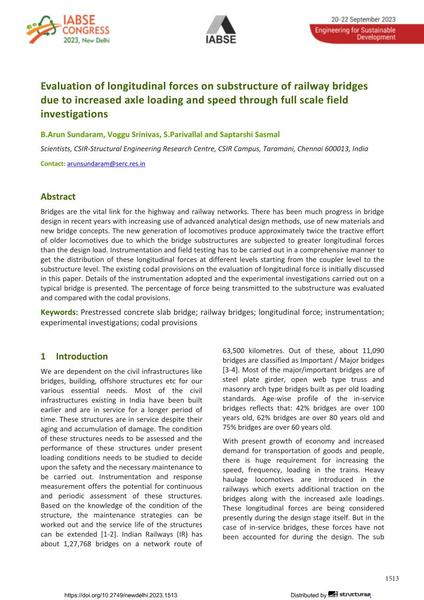Evaluation of longitudinal forces on substructure of railway bridges due to increased axle loading and speed through full scale field investigations

|
|
|||||||||||
Bibliografische Angaben
| Autor(en): |
B. Arun Sundaram
(Scientists, CSIR-Structural Engineering Research Centre, CSIR Campus, Taramani, Chennai 600013, India)
Voggu Srinivas (Scientists, CSIR-Structural Engineering Research Centre, CSIR Campus, Taramani, Chennai 600013, India) S. Parivallal (Scientists, CSIR-Structural Engineering Research Centre, CSIR Campus, Taramani, Chennai 600013, India) Saptarshi Sasmal (Scientists, CSIR-Structural Engineering Research Centre, CSIR Campus, Taramani, Chennai 600013, India) |
||||
|---|---|---|---|---|---|
| Medium: | Tagungsbeitrag | ||||
| Sprache(n): | Englisch | ||||
| Tagung: | IABSE Congress: Engineering for Sustainable Development, New Delhi, India, 20-22 September 2023 | ||||
| Veröffentlicht in: | IABSE Congress New Delhi 2023 | ||||
|
|||||
| Seite(n): | 1513-1520 | ||||
| Anzahl der Seiten (im PDF): | 8 | ||||
| DOI: | 10.2749/newdelhi.2023.1513 | ||||
| Abstrakt: |
Bridges are the vital link for the highway and railway networks. There has been much progress in bridge design in recent years with increasing use of advanced analytical design methods, use of new materials and new bridge concepts. The new generation of locomotives produce approximately twice the tractive effort of older locomotives due to which the bridge substructures are subjected to greater longitudinal forces than the design load. Instrumentation and field testing has to be carried out in a comprehensive manner to get the distribution of these longitudinal forces at different levels starting from the coupler level to the substructure level. The existing codal provisions on the evaluation of longitudinal force is initially discussed in this paper. Details of the instrumentation adopted and the experimental investigations carried out on a typical bridge is presented. The percentage of force being transmitted to the substructure was evaluated and compared with the codal provisions. |
||||
| Stichwörter: |
experimentelle Untersuchungen
|
||||
